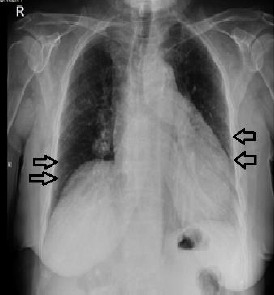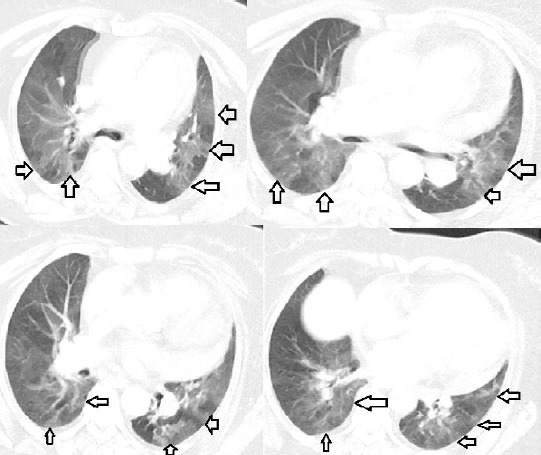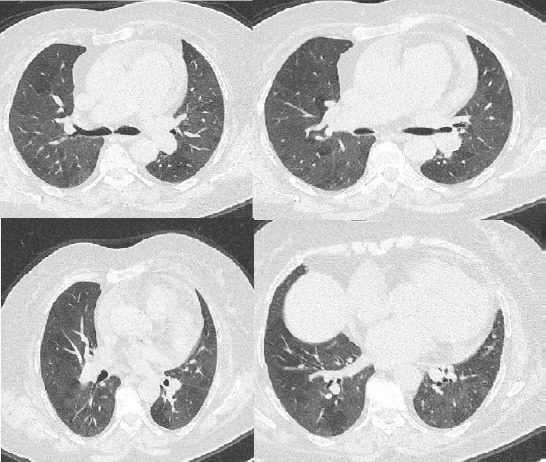Abstract
A 76-year-old female received a severe acute respiratory syndrome coronavirus 2 (SARS-CoV-2) vaccine (CoronaVac, Sinovac®, Beijing, China) and subsequently experienced chest discomfort. A computed tomography performed 1 day after vaccination showed multiple infiltrations in both lungs and ground-glass shadows in both lung fields. Her fingertip oxygen saturation was 81% and there was widespread wheezing on physical examination. Based on these findings, the patient was hospitalized with a preliminary diagnosis of drug-induced pneumonitis and acute asthma exacerbation due to a SARS-CoV-2 vaccine. During her hospitalization, 40 mg/d systemic steroid, 4 times a day salbutamol nebulized, 2 L/min inhaled oxygen therapy and 400 mg/d moxifloxacin intravenous were administered for 5 days. One month later, the thorax computed tomography scan revealed that the previous findings were almost completely regressed.
Keywords: adverse event, allergy, computed tomography, infiltrations, SARS-CoV-2, side effect, systemic inflammation, vaccine
INTRODUCTION
Coronavirus disease 2019 (COVID-19) first appeared in China in December 2019 and was soon declared as a pandemic. The disease has negative effects on economics, health systems and also society, around the world. Shortly after the disease emerged, relevant studies began all over the world, to find a medication to treat the disease and to develop a vaccine to prevent it. Germany, UK, USA, Russia and China developed the first vaccines, and these vaccines have been used in many different parts of the world. Turkey, along with Brazil, is one of the first countries to import and use the vaccine Sinovac® from China. It is reported that the vaccine’s protection rate is 50–83.5%.1,2,3,4 Until now, vaccine-related side effects such as pain at the vaccination site, rash, systemic allergic reaction, cough and fever have been reported.5,6,7,8 We present a patient who presented to our outpatient clinic 1 day after the vaccination with the complaint of severe shortness of breath.
CASE REPORT
A 76-year-old female patient, who did not have a history of close contact with a person with COVID-19, admitted to the outpatient clinic with the complaint of shortness of breath one day after severe acute respiratory syndrome coronavirus 2 (SARS-CoV-2) vaccine (CoronaVac, Sinovac®, Beijing, China). On admission, the patient’s temperature was 36.5°C, respiratory rate was 25 breaths per minute, heart rate was 116 beats per minute, fingertip oxygen saturation (Phillips, Beijing, China) was 81% and there was widespread wheezing in both lung fields. Other systemic examinations were normal. The patient’s previous medical history included bronchial asthma, diabetes mellitus, and hypertension, and her family history was unremarkable. Her body mass index was 32.2 kg/m2. She did not smoke and had not previously suffered an allergic reaction to any medicine or vaccination. In laboratory tests, hemoglobin was measured as 12.2 mg/dL, white blood cell count was 12,600/mm3, eosinophil was 9%, sedimentation was 40 mm/h, C-reactive protein was 25 mg/L and brain natriuretic peptide was 181 ng/L. In the arterial blood gas sample taken in room air, pH was measured as 7.45, partial pressure of oxygen 43 mmHg, partial pressure of carbon dioxide 35 mmHg.
Infiltrations were seen in chest radiography at bilateral lower zones, predominantly peripheral (Figure 1). In the computed tomography (CT); peribronchial thickening in peribronchial subpleural distances, ground-glass shadows, and areas of increased ventilation at the lobular level were observed in all zones and in both lungs (Figure 2). Ejection fraction was 65% in echocardiography, and no pathological change was detected. The SARS-CoV-2 reverse transcriptase ribonucleic acid test for COVID-19 was detected as negative.
Figure 1.

Chest X-ray of the patient: infiltration at bilateral low zones.
Note: Arrows indicate infiltration. R: Right.
Figure 2.

Thorax CT of the patient immediately after the vaccination.
Note: CT shows peribronchial thickening and ground-glass shadows. Arrows indicate ground-glass shadow. CT: Computed tomography.
The patient was hospitalized with a preliminary diagnosis of drug-induced pneumonitis and acute asthma exacerbation. During her hospitalization, 40 mg/d methylprednisolone (Prednol®, Istanbul, Turkey), 4 times a day salbutamol (Ronkotol®, Ankara, Turkey) nebulized and 2 L/min inhaled oxygen therapy and 400 mg/d moxifloxacin (Avelox®, Kirklareli, Turkey) intravenous were administered for 5 days. On the 5th day, the patient’s complaints regressed significantly, and she was discharged with a follow-up appointment after 1 month. One month later, the thorax CT scan revealed that the previous findings were almost completely regressed and there were signs of small airway diseases (Figure 3). The patient, who had no additional complaints, was advised to come to her routine check-ups for asthma.
Figure 3.

Thorax CT of the patient after 1 month.
Note: CT shows signs of small airway diseases, there is no ground-glass shadows. CT: Computed tomography.
DISCUSSION
As COVID-19 vaccines were started to be administered widespread, a wider spectrum of side effects started to be seen. Local side effects such as increased temperature, redness and pain at the vaccination site are quite common, while systemic side effects are less commonly seen.5,6,7,8 We think that the patient, who developed shortness of breath one day after the vaccination and had infiltrations in the CT of the thorax, had these symptoms and findings due to the vaccine. Although there is no such side effect defined in the literature due to CoronaVac (Sinovac®, Beijing, China) vaccine, there is a case of systemic inflammatory response syndrome reported by Steinberg et al.9 due to mRNA-1273 SARS-CoV-2 vaccine. Our patient’s clinic did not fulfill the systemic inflammatory response syndrome criteria. However, as the patient’s complaints started right after vaccination and there were infiltrative images present on chest radiography, these may support that the patient had a systemic inflammatory response.
Numata et al.10 published a case report in 2018, in which, the patient developed pulmonary infiltrates after receiving seasonal flu vaccine. They diagnosed the patient with drug-induced pneumonitis with the trans-bronchial lung biopsy performed, and followed up without treatment. They reported that the patient’s findings resolved completely after 6 months. Although pathological examination was not performed in our case, we thought that the suddenly developed infiltrations might be a reaction to the vaccine. Computed tomography of the patient, whose complaints disappeared after a short-term steroid treatment, infiltration was almost completely regressed in the CT performed 1 month later.
To conclude, COVID-19 vaccines are fairly new vaccines. It is apparent that as the number of vaccinations increases, side effects related to the vaccine will emerge in more detail. We think that in patients developing sudden shortness of breath after vaccination, this entity should be taken into consideration.
Footnotes
Conflicts of interest
No.
Financial support
None.
Institutional review board statement
In Turkey, case reports do not require ethical approval.
Declaration of participant consent
Written informed consent was obtained from the patient.
Reporting statement
This study follows the CAse REport (CARE) statement.
Copyright license agreement
The Copyright License Agreement has been signed by both authors before publication.
Data sharing statement
Datasets analyzed during the current study are available from the corresponding author on reasonable request.
Plagiarism check
Checked twice by iThenticate.
Peer review
Externally peer reviewed.
REFERENCES
- 1.Palacios R, Patiño EG, de Oliveira Piorelli R, et al. Double-Blind, Randomized, Placebo-Controlled Phase III Clinical Trial to Evaluate the Efficacy and Safety of treating Healthcare Professionals with the Adsorbed COVID-19 (Inactivated) Vaccine Manufactured by Sinovac - PROFISCOV: A structured summary of a study protocol for a randomised controlled trial. Trials. 2020;21:853. doi: 10.1186/s13063-020-04775-4. [DOI] [PMC free article] [PubMed] [Google Scholar]
- 2.World Health Organization. The Sinovac COVID-19 vaccine: What you need to know. [Accessed by July 27, 2021]. https://www.who.int/news-room/feature-stories/detail/the-sinovac-covid- 19-vaccine-what-you-need-to-know.
- 3.Tanriover MD, Doganay HL, Akova M, et al. Efficacy and safety of an inactivated whole-virion SARS-CoV-2 vaccine (CoronaVac): interim results of a double-blind, randomised, placebo-controlled, phase 3 trial in Turkey. Lancet. 2021;398:213–222. doi: 10.1016/S0140-6736(21)01429-X. [DOI] [PMC free article] [PubMed] [Google Scholar]
- 4.Baraniuk C. What do we know about China’s covid-19 vaccines. BMJ? 2021;373:n912. doi: 10.1136/bmj.n912. [DOI] [PubMed] [Google Scholar]
- 5.Zhang Y, Zeng G, Pan H, et al. Safety, tolerability, and immunogenicity of an inactivated SARS-CoV-2 vaccine in healthy adults aged 18-59 years: a randomised, double-blind, placebo-controlled, phase 1/2 clinical trial. Lancet Infect Dis. 2021;21:181–192. doi: 10.1016/S1473-3099(20)30843-4. [DOI] [PMC free article] [PubMed] [Google Scholar]
- 6.Sharma O, Sultan AA, Ding H, Triggle CR. A review of the progress and challenges of developing a vaccine for COVID-19. Front Immunol. 2020;11:585354. doi: 10.3389/fimmu.2020.585354. [DOI] [PMC free article] [PubMed] [Google Scholar]
- 7.Cebeci F, Kartal İ. Petechial skin rash associated with CoronaVac vaccination: first cutaneous side effect report before phase 3 results. Eur J Hosp Pharm. 2021 doi: 10.1136/ejhpharm-2021-002794. doi: 10.1136/ejhpharm-2021-002794. [DOI] [PMC free article] [PubMed] [Google Scholar]
- 8.Healthline Media UK Ltd. Sinovac COVID-19 vaccine: What are the side effects? [Accessed by July 28, 2021]; https://www.medicalnewstoday.com/articles/sinovac-covid-19-vaccine-whatare- the-side-effects. [Google Scholar]
- 9.Steinberg J, Thomas A, Iravani A. (18)F-fluorodeoxyglucose PET/CT findings in a systemic inflammatory response syndrome after COVID-19 vaccine. Lancet. 2021;397:e9. doi: 10.1016/S0140-6736(21)00464-5. [DOI] [PMC free article] [PubMed] [Google Scholar]
- 10.Numata T, Hida N, Yazaki K, et al. Seasonal influenza vaccine-induced pneumonitis presenting with multiple pulmonary nodules. Intern Med. 2018;57:707–711. doi: 10.2169/internalmedicine.9399-17. [DOI] [PMC free article] [PubMed] [Google Scholar]


